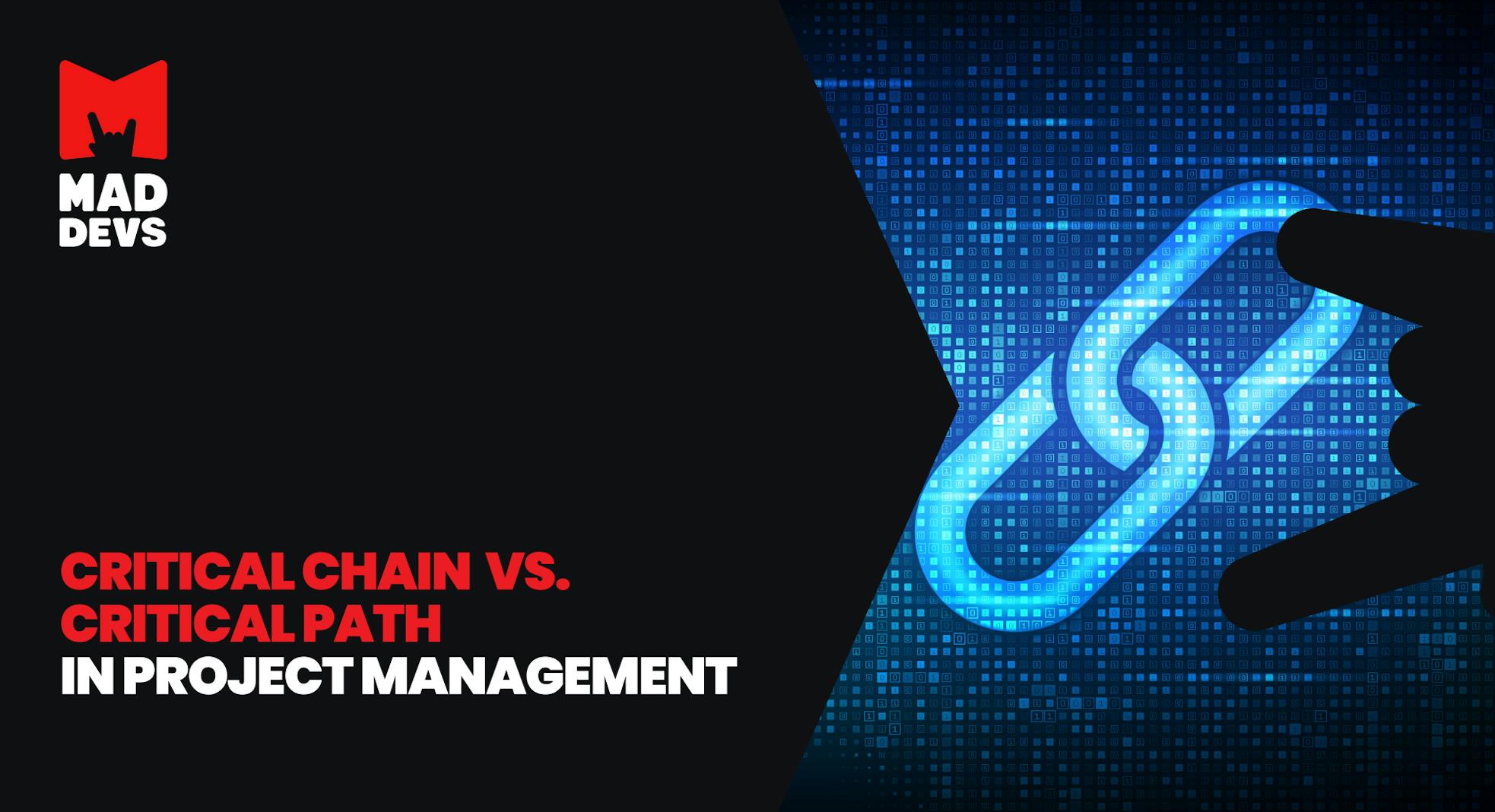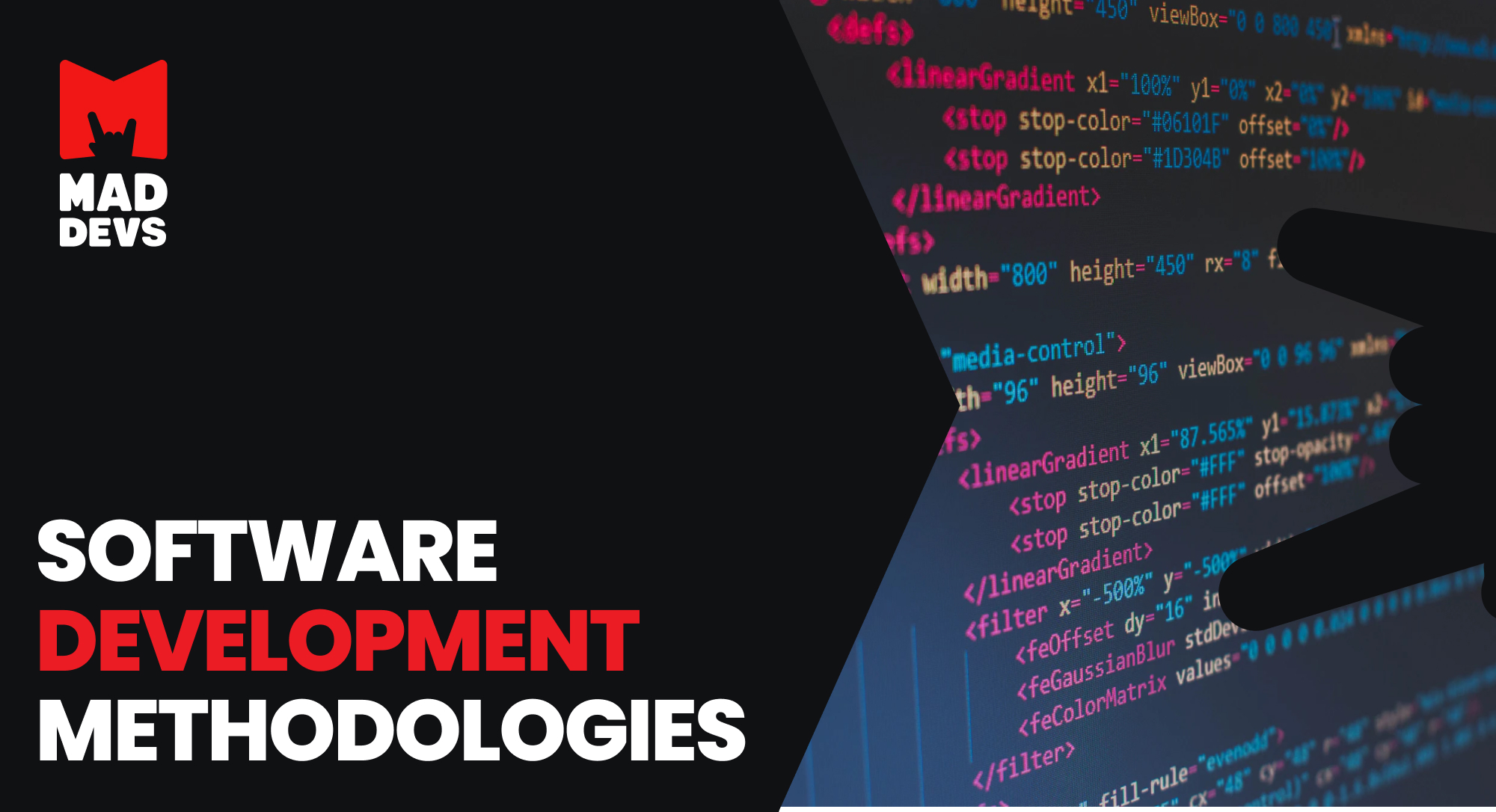Project management encompasses a multitude of methodologies, many of which were developed a long time ago but continue to evolve and find repeated application. This is particularly evident in the emergence and advancement of platforms that facilitate using these methodologies, enhancing and complementing them with their technologies.
Today, we will explore one of the most solid and influential methodologies called critical chain. We will also help answer questions such as:
- What is the role of the critical chain in project management?
- What is the difference between a critical chain and a critical path?
- What are the advantages and unique features of the critical chain?
- Can you provide concrete examples of projects that utilize the critical path?
- And what is the best software for implementing critical chain in your projects?
All of these topics will be covered in our article. Rewarding reading for you!
What is the critical chain?
Critical chain project management (CCPM) is an approach to project planning and management that focuses on resources and is geared towards optimizing the use of key project resources. This method considers not only task dependencies but also resource constraints, and it attempts to reduce the impact of uncertainty and variability on the project.
Where did the idea of the Critical Chain come from?
In 1984, Eliyahu Goldratt first presented his Theory of Constraints (TOC) in the book "The Goal." The essence of the TOC is that the efficiency of any system (including a project) is determined by the presence of one or more limiting factors. The system's operation can be improved by managing these constraining factors.
Why has the critical chain method become so important?
Several key factors contribute to its significant influence on general project management practices.
The first and most obvious aspect is that many companies that have implemented the critical chain methodology have reported a noticeable increase in the efficiency of their projects. History shows that companies that early believed in this methodology became the largest beneficiaries at the time; for instance, Seagate brought 1st 15,000 rpm disc drive to market ahead of its competition, causing all competition to pull out of the market. Lucent Technologies Outside Plant Fiber Optic Cable Business Unit reduced its product introduction interval by 50%, improved on-time delivery, and increased its product development capacity. And more and more companies, especially with emerging more convenient tools for it.
The second aspect is that introducing the critical chain methodology has contributed to revising project management standards. Many of the principles and techniques embedded there have been reflected in the new PMBOK (Project Management Body of Knowledge) and PRINCE2 (Projects IN Controlled Environments) standards, indicating international recognition of the effectiveness of these approaches.
The third aspect is related to the critical chain methodology's innovative potential. The new perspective on resource and time management proposed within this concept has stimulated the development of new approaches and technologies in project management.
For instance, critical chain concepts in software project management are applied in Agile project management methodology. Adaptability, flexibility, and continuous process improvement all became possible thanks to the resource and time management principles established there.
Lean project management methodology is based on the principles of Lean manufacturing, which were first described in Goldratt's works. It assumes maximum optimization of all processes and resources, minimization of waste, and more efficient use of resources, aligning with many CCPM principles.
Thus, the CCPM has significantly impacted project management, influencing its standards and stimulating the development of new approaches and technologies.
What is the difference between a critical chain and a critical path?
The difference between the critical path and the critical chain in project management is mainly in relation to time for project execution and accounting for resources other than the time needed to complete the project.
Typically, CPM focuses on identifying critical and non-critical tasks needed to drive and complete a project. In this way, it avoids uncertainty in non-critical paths, preventing slowdowns and eliminating blocks in the critical path. However, CPM may not save if resources become limiting factors that this methodology does not consider.
CCPM, on the other hand, offers not just an accounting of both time and other resources but a different way to handle them. Instead of simply defining a sequence of dependent tasks and the maximum time needed to complete them, as CPM does, CCPM defines the optimal time to complete them, as well as considering the available human and material resources, enabling their reallocation over the project's progress, providing more accurate management and rapid progress.
📖 To better understand the difference between the critical path and the critical chain, we highly recommend reading first our article What is the Critical Chain in Project Management?
Critical chain features
To understand how exactly the critical chain methodology provides such excellent results, we need to look more closely into its technical features.
- Resource orientation. Instead of managing the project strictly from the perspective of individual tasks and their completion deadlines, the focus shifts to the human, material, and temporal resources necessary to complete these tasks. This management involves more accurate planning and forecasting of resource needs to avoid shortages or excess, ultimately leading to increased work efficiency.
- Time and resource buffers. A project buffer is a time reserve that is added to the project's completion deadline instead of adding time reserves to individual tasks. It allows for potential risks and delays to be considered without negatively impacting the overall project schedule. Feeding buffers are additional time added to non-critical paths in the project to prevent their impact on the critical chain. And resource buffers are also added to whole paths that consider the human, material, and other resources available to perform tasks.
- Elimination of multitasking. Minimizing multitasking implies focusing resources on completing one task at a time instead of simultaneously distributing them among several tasks. This approach leads to less time wasted on switching between tasks and an increase in overall productivity.
- Priority management. Tasks that contribute the most to the project's success are tracked and prioritized, ensuring their timely completion. It ensures transparency and clarity in determining the importance of tasks, allows for more effective use of limited resources, and reduces the risk of delays and budget overruns.
Critical chain diagram example
Here is an important point to note: while the critical chain is a different approach to project management than the critical path, it becomes so by extending the critical path approach, not excluding it. So let's imagine we need to develop a feedback form on the website using the critical chain.
| Activity | Description | Estimated time (days) | Immediate predecessor |
|---|---|---|---|
| A | Gather website requirements | 2 | - |
| B | Create design mockups in Figma | 5 | A |
| C | Plan website architecture | 3 | A |
| D | Deploy on staging | 2 | C |
| E | Design landing page | 2 | B |
| F | Design news feed page | 3 | B |
| G | Design subscription page | 3 | B |
| H | Implement landing page | 1 | E, C |
| I | Implement news feed page | 5 | F, C |
| J | Implement subscription page | 4 | G, C |
| K | Test success flow | 3 | D, H, I, J |
| L | Release (deploy to production) | 3 | K |
First and foremost, we need to identify the necessary participants, all the tasks and subtasks required, and estimate the possible duration of their execution. We will highlight the main of these simple vision following explanations.
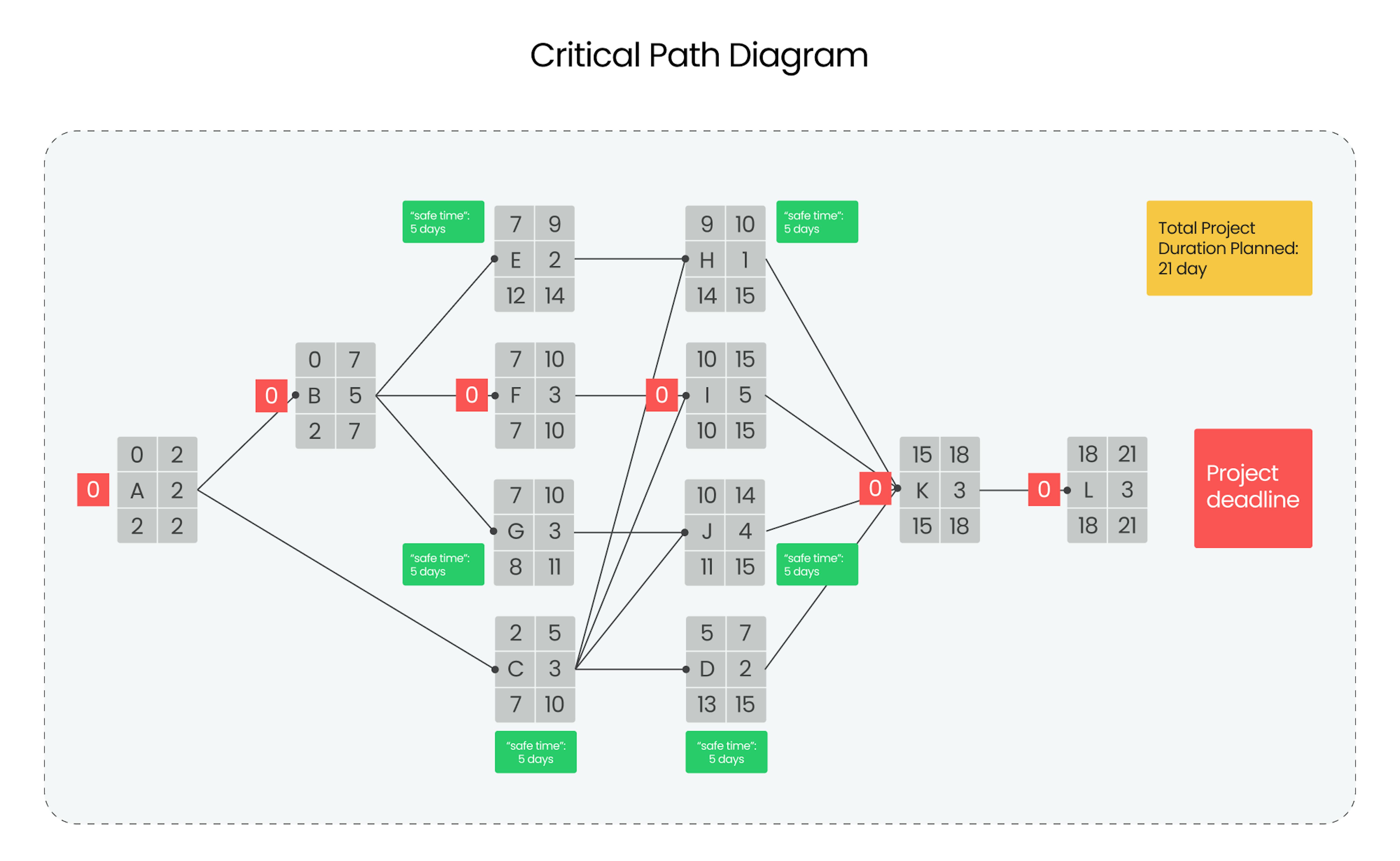
As mentioned earlier, we can't immediately move on to building the critical chain diagram without a critical path diagram. So once it's done, we can start updating it to the critical chain.
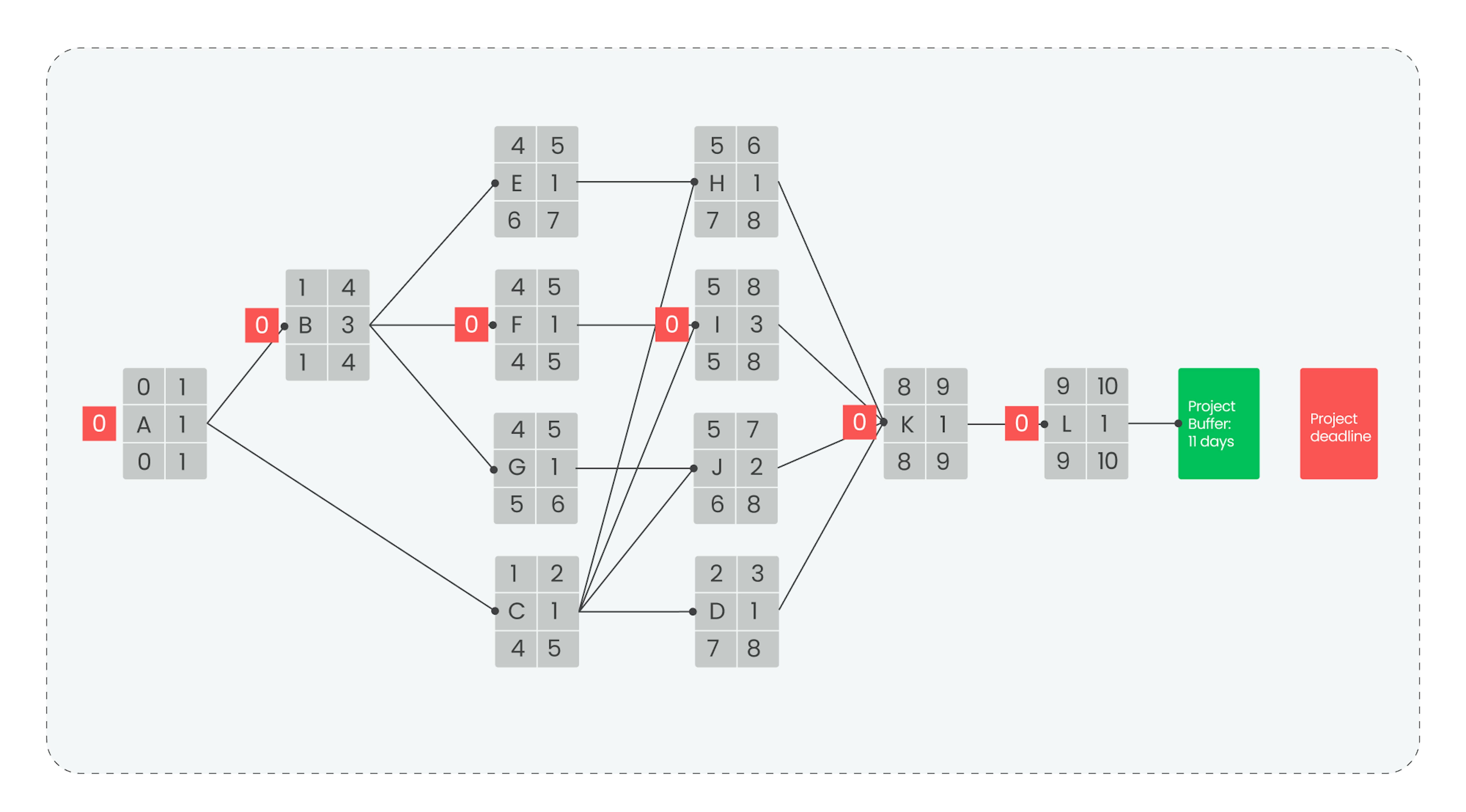
Guided by Pareto's law, a person spends on a task as much as was allocated to it, and the critical chain eliminates that. The key thought here is that the critical path is based on the maximum probable time to complete tasks, including extra time into each one. But here, we take the minimum possible time to complete a task, stimulating its execution with minimal time without adding it to each task. Instead, we include extra time into a separate overall project buffer, from which it will be taken if necessary.
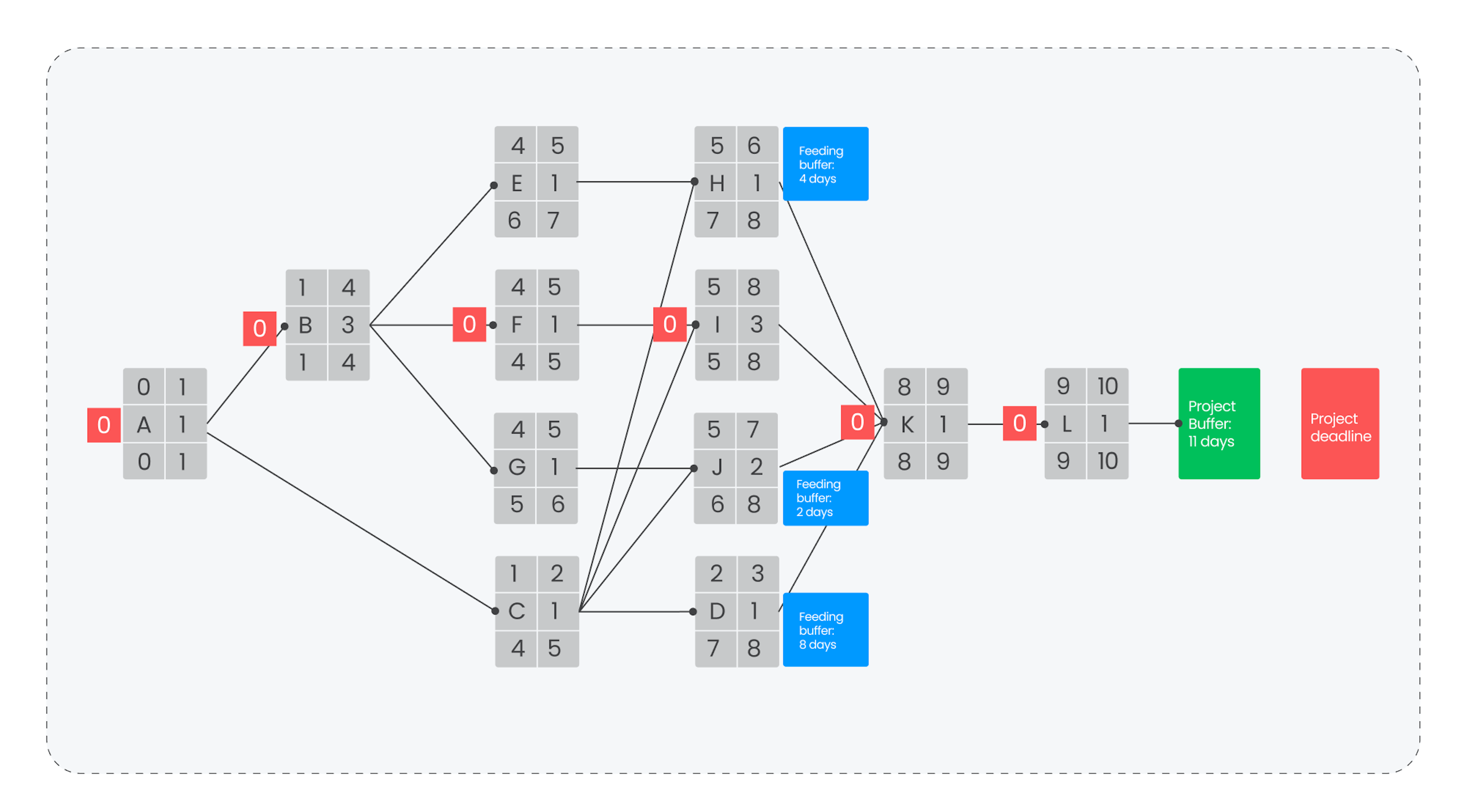
Next, we add feeding buffers that we do not assign to individual tasks but to entire paths. If more time is required for one of the tasks on some non-critical path, then this feeding buffer must first be exhausted before taking time from the main project buffer. And if it has not been exhausted after completing the tasks on the path, we can allocate the remaining time to other feeding buffers. So that even if additional time is required for a task, we do not directly affect the сritical сhain and project buffer.

And then, we add resource buffers, which account for the availability of human or material resources. For example, we have only one designer on the project, which means we are limited to 8 hours per design per day, as well as the parallel execution of multiple design tasks. However, if we were to add another designer, we would have twice as many resources per design, and the tasks could run in parallel, which would greatly change the resource buffers and the rest of the critical chain. If a single designer completes a task earlier than planned, the resource buffer will be freed up and allocated to another resource buffer.
Of course, the critical chain implies many more details, further optimizing project development and making their assessment more efficient, realistic, and predictable. However, this is the key difference between the critical path and the critical chain in their building and use.
Best critical chain software
Many software is available today that utilize the critical chain for project management, offering a range of relevant features as well as numerous unique additions and specialties.
- Lynx TameFlow offers process streamlining with a focus on identifying and eliminating bottlenecks. It employs the principles of the Theory of Constraints to optimize project efficiency. This platform also supports deep analytics and reporting for continuous process improvement.
- Being Management 3 combines Agile, Lean, and Critical Chain Project Management into a unique project management space. It supports workflow management, which aids in improving team coordination and accelerating project execution.
- Exepron has a built-in analytical engine, which provides continuous project monitoring, automatically identifies potential risks, and suggests solutions to prevent delays. The platform offers cloud services, making it accessible for teams of any size.
- ProChain provides features for managing time buffers, which help accurately manage project timelines and reduce the impact of potential delays. The software also supports multi-project management, simultaneously coordinating multiple projects.
- Concerto has a proprietary algorithm for automatic task distribution and team load balancing. This algorithm is designed to maximize teamwork efficiency and ensure accurate project planning.
- Aurora-CCPM is designed for handling complex and multitasking projects based on the critical chain method. It uses an intelligent planning algorithm that adapts the project map to account for unexpected changes and maximize productivity.
- Milliarum SAP offers deep integration with the SAP ecosystem, enabling a comprehensive critical chain project management solution. Its distinguishing feature is its ability to seamlessly interact with other SAP modules to coordinate project management with other company business processes.
How to choose critical chain software?
Choosing suitable software remains a complex task, as each includes a wide range of functionalities and depends on many factors, including the specifics of your projects, your functional requirements, budget, and resources, as well as your team's preferences. Here, you can find a brief comparison from The Critical Chain Projects site to help you decide:
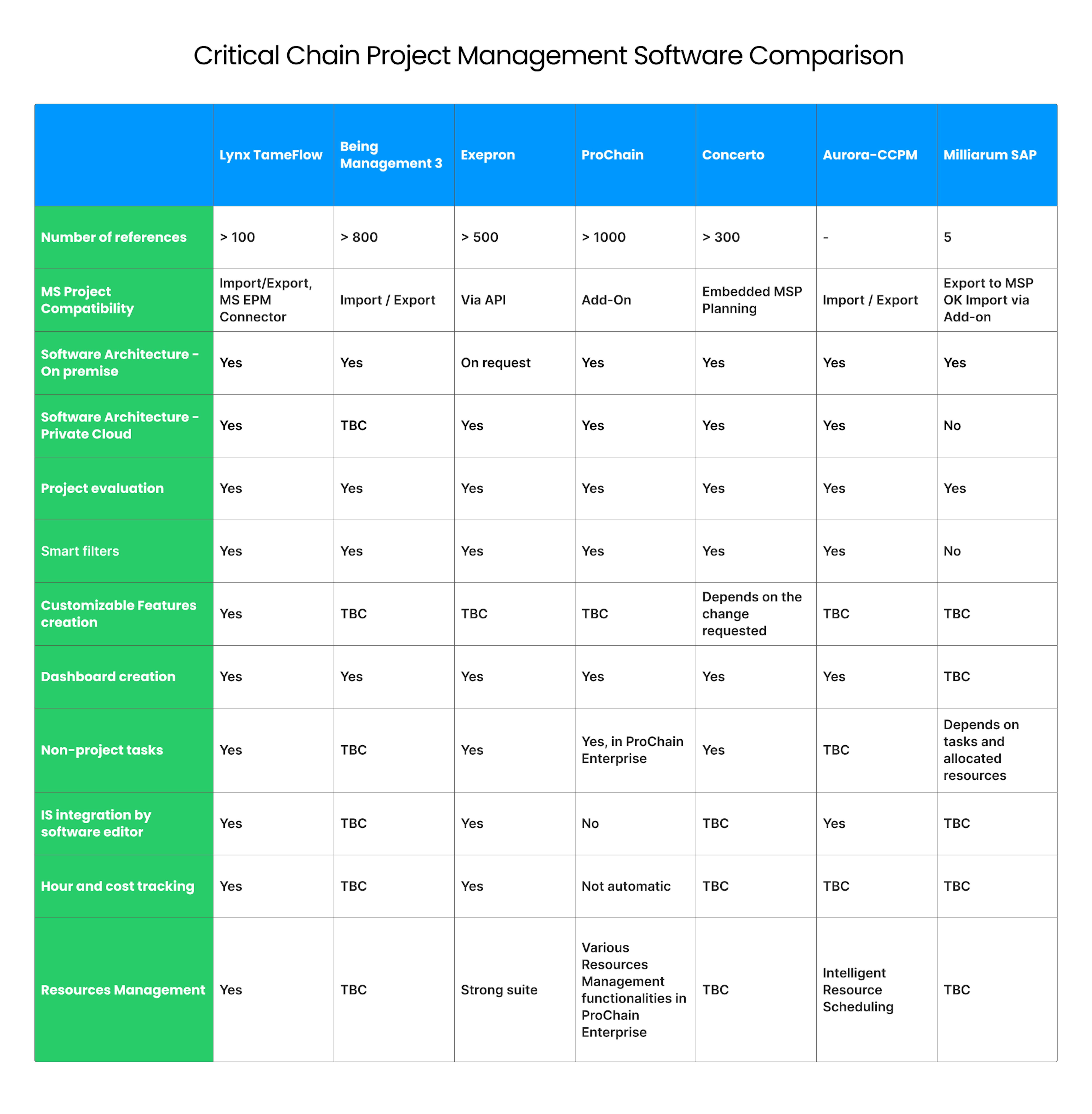
Summary
Now you clearly understand what critical chain is in project management and how it has revolutionized industries. You saw the advantages of a critical chain over a critical path through illustrative examples. And you are now aware of the powerful tools employed by critical chain to elevate your own development and production processes.
Of course, our experts are available for a free consultation if you still have questions and need to optimize and automate your processes, whether by implementing existing solutions or developing custom ones.

